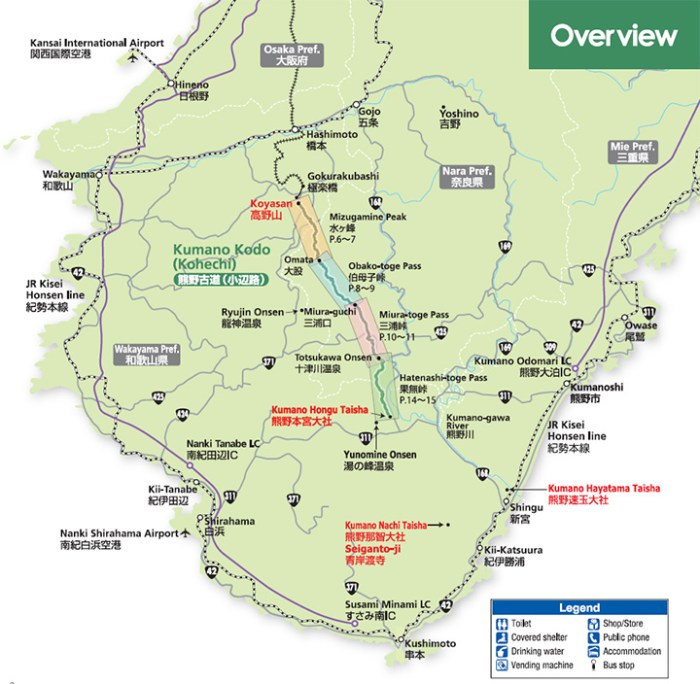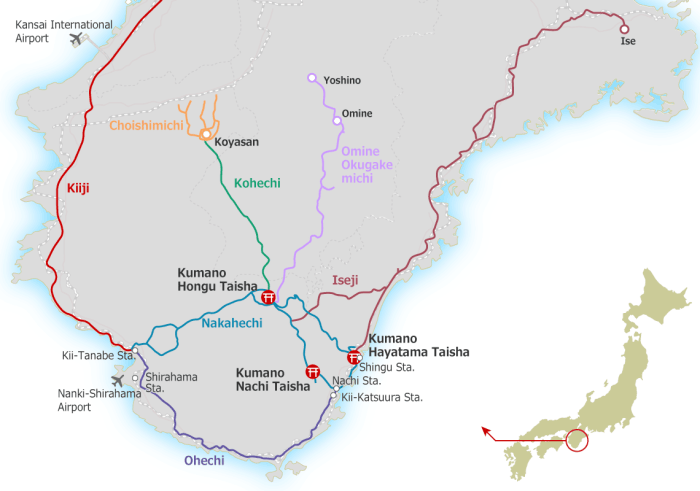Embark on a spiritual journey through time with the Kumano Kodo Trail Map, a comprehensive guide to Japan’s ancient pilgrimage path. Discover the history, significance, and captivating landscapes that have drawn pilgrims for centuries.
This interactive map charts the various routes of the Kumano Kodo, providing detailed descriptions of each section, including distance, elevation gain, and estimated hiking time. Key points of interest, such as shrines, temples, and villages, are marked for easy navigation.
Kumano Kodo Trail Overview: Kumano Kodo Trail Map

The Kumano Kodo Trail is an ancient pilgrimage route in Japan that has been traversed by millions of people for centuries. The trail winds through the mountainous terrain of the Kii Peninsula, connecting several sacred sites. It is a UNESCO World Heritage Site and is considered one of the most important pilgrimage routes in Japan.
The Kumano Kodo Trail is divided into several different routes, each with its own unique length and duration. The most popular route is the Nakahechi Route, which is about 170 kilometers long and takes about 5-7 days to complete. Other routes include the Kohechi Route, which is about 70 kilometers long and takes about 3-4 days to complete, and the Ohechi Route, which is about 90 kilometers long and takes about 4-5 days to complete.
The Kumano Kodo Trail Map is a detailed guide to one of Japan’s most famous pilgrimage routes. The trail winds through the mountains and valleys of the Kii Peninsula, and offers stunning views of the surrounding countryside. Along the way, pilgrims can visit ancient temples and shrines, and learn about the history and culture of the region.
For those interested in learning more about Nathan Buckley’s new girlfriend, click here: Nathan Buckley New Girlfriend . After learning about Nathan Buckley’s new girlfriend, be sure to return to the Kumano Kodo Trail Map to continue your journey through this beautiful and historic region.
Map Exploration
The Kumano Kodo Trail is well-marked and easy to follow. There are several interactive maps available online that can help you plan your hike. One of the most popular maps is the Kumano Kodo Trail Map, which provides detailed information about the trail, including its elevation profile, points of interest, and accommodation options.
Trail Sections
The Kumano Kodo Trail is divided into several distinct sections, each with its own unique challenges and rewards. The first section, from Takijiri-oji to Hongu Taisha, is relatively easy and can be completed in a day. The second section, from Hongu Taisha to Nachi Taisha, is more challenging and takes about 2-3 days to complete.
The third section, from Nachi Taisha to Kumano Hayatama Taisha, is the most challenging and takes about 3-4 days to complete.
Each section of the Kumano Kodo Trail offers its own unique rewards. The first section passes through beautiful forests and offers stunning views of the surrounding mountains. The second section passes through several sacred sites, including the Kumano Nachi Taisha, which is one of the most important shrines in Japan.
The third section passes through a remote and rugged landscape, and offers a chance to experience the true wilderness of the Kii Peninsula.
Accommodation and Amenities
There are a variety of accommodation options available along the Kumano Kodo Trail. These include guesthouses, campsites, and hotels. Guesthouses are the most popular option, and they offer a range of amenities, including meals, showers, and laundry services.
There are also several campsites along the trail. These are a good option for budget travelers, and they offer a chance to camp under the stars. However, it is important to note that campsites are often located in remote areas, and they may not have access to running water or electricity.
Planning and Logistics
Planning a hike on the Kumano Kodo Trail is relatively easy. The first step is to decide which route you want to hike. Once you have chosen a route, you can start planning your itinerary. It is important to book your accommodation in advance, especially if you are hiking during peak season.
The Kumano Kodo Trail is well-marked and easy to follow. However, it is important to be prepared for all types of weather conditions. It is also important to bring plenty of water and snacks, as there are not many places to buy food along the trail.
Cultural and Spiritual Significance
The Kumano Kodo Trail has been a pilgrimage route for centuries. Pilgrims from all over Japan would travel to the Kumano region to visit the sacred sites. The trail is still popular today, and it is a great way to experience the cultural and spiritual heritage of Japan.
The Kumano region is home to several important shrines and temples. The most important shrine is the Kumano Hongu Taisha, which is said to be the home of the god Susanoo-no-Mikoto. Other important shrines include the Kumano Nachi Taisha and the Kumano Hayatama Taisha.
Natural Beauty and Landscapes
The Kumano Kodo Trail passes through some of the most beautiful scenery in Japan. The trail winds through forests, mountains, and valleys. It also passes by several waterfalls and hot springs.
One of the most popular attractions on the Kumano Kodo Trail is the Nachi Falls. This is one of the tallest waterfalls in Japan, and it is a popular spot for swimming and hiking. Another popular attraction is the Kumano Kodo Museum, which tells the story of the trail and its history.
Safety and Regulations, Kumano Kodo Trail Map
The Kumano Kodo Trail is a safe trail to hike. However, it is important to be aware of the risks involved in hiking. These risks include wildlife encounters, weather conditions, and altitude sickness.
It is important to be prepared for all types of weather conditions. The weather in the Kumano region can change quickly, so it is important to bring rain gear and warm clothing. It is also important to bring plenty of water and snacks, as there are not many places to buy food along the trail.
Ending Remarks

The Kumano Kodo Trail Map is an indispensable tool for planning an unforgettable pilgrimage along this sacred path. Whether you seek cultural immersion, spiritual enlightenment, or simply an awe-inspiring hiking experience, this map will guide you every step of the way.
FAQ Guide
What is the Kumano Kodo Trail?
For those planning to embark on the Kumano Kodo Trail, detailed maps are essential for navigating the ancient pilgrimage route. To supplement your preparations, consider reading the intriguing article ” Aita For With My Girlfriend After She Rejected My Proposal ” for insights into human relationships.
Upon completing the trail, the maps will serve as cherished mementos of your spiritual journey.
The Kumano Kodo Trail is a network of ancient pilgrimage routes in Japan that lead to the sacred Kumano Sanzan shrines.
How long is the Kumano Kodo Trail?
The Kumano Kodo Trail consists of several routes ranging in length from 30 to 100 kilometers.
What is the best time to hike the Kumano Kodo Trail?
Spring and autumn are the most popular seasons for hiking the Kumano Kodo Trail due to the mild weather.
What are the accommodations like along the Kumano Kodo Trail?
There are a variety of accommodations available along the Kumano Kodo Trail, including guesthouses, campsites, and hotels.

.gallery-container {
display: flex;
flex-wrap: wrap;
gap: 10px;
justify-content: center;
}
.gallery-item {
flex: 0 1 calc(33.33% – 10px); /* Fleksibilitas untuk setiap item galeri */
overflow: hidden; /* Pastikan gambar tidak melebihi batas kotak */
position: relative;
margin-bottom: 20px; /* Margin bawah untuk deskripsi */
}
.gallery-item img {
width: 100%;
height: 200px;
object-fit: cover; /* Gambar akan menutupi area sepenuhnya */
object-position: center; /* Pusatkan gambar */
}
.image-description {
text-align: center; /* Rata tengah deskripsi */
}
@media (max-width: 768px) {
.gallery-item {
flex: 1 1 100%; /* Full width di layar lebih kecil dari 768px */
}
}